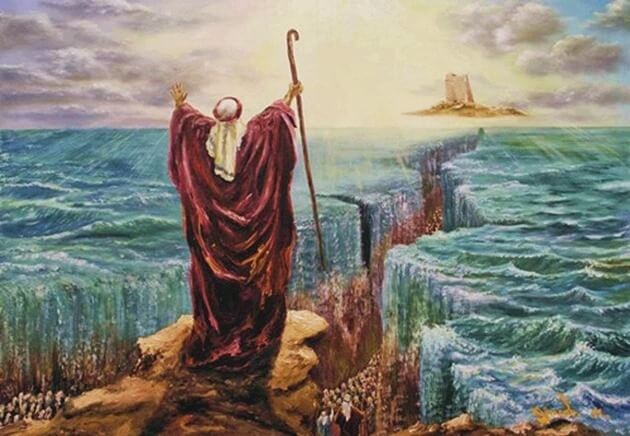Bonjour / Hello [nickname_else_first_name],

Tu BiShvat (Hebrew: ט״ו בִּשְׁבָט, romanized: Ṭū BiŠəvāṭ, lit. '15th of Shevat') is a Jewish holiday occurring on the 15th day of the Hebrew month of Shevat (in 2023, Tu BiShvat begins at sunset on February 5 and ends in the evening of February 6). It is also called Rosh HaShanah La'Ilanot (Hebrew: ראש השנה לאילנות), literally "New Year of the Trees". In contemporary Israel, the day is celebrated as an ecological awareness day, and trees are planted in celebration.
-Wikipedia
Table of contents
1) Perashat Hashavoua - Rabbi Eli Mansour
2) Halakhat Hashavoua (Halakhot related to day to day life) By Hazzan David Azerad - Halachot Tu'Bshvat
3) Holy Jokes!
1)PERASHAT HASHAVOUA
This Week's Parasha Insight with Rabbi Eli Mansour
Parashat BeShalah- A New Understanding of the Splitting of the Sea
Parashat Beshalah describes what is likely the most famous miracle told in the Torah – the miracle of Keri’at Yam Suf, the splitting of the Sea of Reeds. Pharaoh’s army had trapped Beneh Yisrael against the sea, and G-d miraculously split the sea to allow Beneh Yisrael to cross. The Egyptians continued chasing Beneh Yisrael into the sea, whereupon G-d sent the waters on them, drowning the entire army.
The Ha’ketab Ve’ha’kabbala (Rav Yaakob Mecklenberg, 1785-1865) offers a unique insight into how the miracle of Keri’at Yam Suf unfolded, understanding this event much differently than the way it is commonly understood.
He begins by noting that the Torah speaks of Beneh Yisrael going into the sea with the words, "Va’aybo’u Beneh Yisrael Be’toch Ha’yam" – "Beneh Yisrael came into the middle of the sea" (14:22). Ha’ketab Ve’ha’kabbala observes that generally, the act of going into the sea is referred to not with the verb "B.A." – "come," but rather with the verb "Y.R.D." – "descend." For example, a verse in Tehillim (107:23) speaks of "Yoredeh Ha’yam Ba’oniyot" – "Those who go down into the sea in boats." Why does the Torah use the verb "Va’yabo’u" – "came" – in reference to Beneh Yisrael’s going into the sea after the waters split?
To answer this question, Ha’ketab Ve’ha’kabbala explains that the splitting of the waters was not the primary miracle that occurred at this event. Rather, G-d lifted the ocean floor, such that it was flush with the seashore. The water, which would normally be displaced and thrown onto the shores around the ocean, instead split into two "walls" that floated on top of the elevated ocean floor, on either side. Additionally, G-d dried the ocean floor so that it was smooth and paved, allowing Beneh Yisrael to easily travel across to the other side.
This explains why the Torah uses the word "Va’yabo’u" to describe Beneh Yisrael’s advancing into the sea. Normally, the verb "Y.R.D." is used, because the ocean is, of course, much lower than the shore, such that going into the sea entails a descent of sorts. But at Keri’at Yam Suf, the ocean floor was lifted, such that Beneh Yisrael did not have to descend. This was, in fact, a crucial part of the miracle. If G-d had merely split the waters, Beneh Yisrael would have needed to walk along a steep depression down into the ocean floor. This would have been exceedingly difficult. And so instead, G-d raised the ocean floor, splitting the water in the process, so Beneh Yisrael had a flat, smooth surface along which the travel.
Ha’ketab Ve’ha’kabbala explains on this basis Beneh Yisrael’s description of the miracle in the Shirat Ha’yam – the song of praise which they sang after the miracle: "Kaf’u Tehomot Be’leb Yam" (commonly translated as, "The depths froze in the heart of the sea" – 15:8). Based on several verses throughout Tanach, Ha’ketab Ve’ha’kabbala posits that the word "Kaf’u" means "float." And, he cites the verse in the Book of Mishleh (30:19), "Derech Oniya Be’leb Yam" – that ships sail "in the heart of the sea," showing that the phrase "Be’leb Yam" refers to the surface of the ocean. Hence, the verse "Kaf’u Tehomot Be’leb Yam" means that the ocean waters "floated" on top of the sea’s surface, which was elevated to the height of the shore.
The real miracle of Keri’at Yam Suf, then, was not just the splitting of the water – but the elevation of the ocean floor, which created a flat, smooth surface for Beneh Yisrael to travel on so they could easily escape from the Egyptian army.
2) HALAKHAT HASHAVOUA
Halachot this week are selected and Translated by Hazzan David Azerad
Halachot for Tu Bishvat
The 15th of the month of Shevat is Rosh Hashana for the trees. Opinions differ as to whether to say Tahanon the day before however, it is customary not to say Tahanon.
Some have the Minhag to study on the night of the 15th of Shevat the Seder from the book “Peri Etz Hadar”.
It is customary to eat many fruits at night and on the 15th day of Shevat, and we try to have first fruits with which the Land of Israel was praised. , such as the olive the date the fig, pomegranate, and raisins.
During Tu Bishvat one should pray for a nice and Kosher Etrog for Sukkot
On Tu Bishvat we are not allowed to fast
The order of the berachot should be the following. We start with Mezonot then Hagefen, Bore Peri Haatz, Bore Peri Ha’adama then Shehakol.
At the end, we do the Beracha Al Hamichya
Bevirkat Shabbat Shalom Umevorach
David Azerad
3) HOLY JoKeS!!
Selection of funny snippets, loosely related to this weeks parashah or current events, to brighten your day
When the Egyptians say that the Red Sea split for the Jewish people, they were sure that it would split for them as well. They all went charging into the Red Sea, only to have the water come crashing down on their heads. Thousands of gallons of water falling on your head can be very painful. But this was not just an ordinary headache. It was a SPLITTING HEADACHE!
-Torahmates












